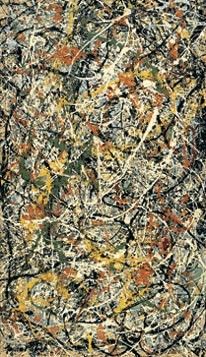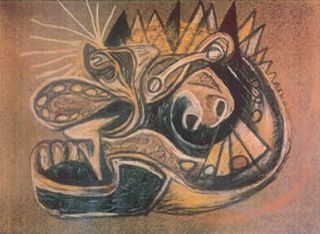Bipolar Disorder
Jackson Pollock's Creation of Abstract Expressionism
Pollock used the creative janusian process and overcame bipolar symptoms
Posted August 22, 2017
Jackson Pollock (1912–1956) was the founder of the Abstract Expressionist Movement in art. This was the first truly American artform and its development had worldwide repercussions. Whereas up to the time of the artform’s appearance, France had been considered the art center of the world, abstract impressionism moved the focus of the art world to the United States where it has remained ever since.
Pollock ushered in the abstract expressionist form with the genesis of a dramatic new style of painting which has been given such names as “drip painting” or “action painting.” An example drawn from his works, entitled “Number Three, Tiger, 1949” is shown in Figure 1.

The initial formulations leading to the creation of this form of painting occurred while the artist was in psychiatric treatment and at a point when his bipolar illness was showing improvement. He achieved this creation through the healthy janusian process.
Evidence for the diagnosis of Pollock’s bipolar illness is based on the report by his treating psychiatrist Dr. Richard Hendersen of periods of “violent agitation” alternating with “paralysis or withdrawal” (3), another therapist Dr. Violet de Laszlo’s direct assessment that Pollock was “manic depressive” (2), and his wife Lee Krasner’s description of his extremes of temperament and behavior as follows: “Whatever Jackson felt, he felt more intensely than anyone I’ve known; when he was angry, he was angrier; when he was happy, he was happier; when he was quiet, he was quieter” (1). Pollock used alcohol in excess to deal with his mood upheavals.
In an unusual public presentation of psychiatric treatment, Dr. J. Hendersen, who became Founder of the Jungian Institute in San Francisco, gave an open lecture to colleagues about his therapy of Jackson Pollock from late 1938 to September 1940. (4) In this therapy, as is commonly practiced by Jungians, the patient Pollock regularly delivered drawings and other artwork to his sessions for analysis. Eighty-three of these works were preserved by Dr.Hendersen. Although the exact sequence of the creation of the artworks is not known, a distinctly early one is shown in Figure 2.

Figure 2 early work.
This and many subsequent works show the influence of his mentors, Thomas Hart Benton, Diego Rivera, Jose Clemente Orosco and other Mexican muralists. It is a large, brightly colored drawing with a suggestion of an Aztec or other native Mexican icon. There is also an otherworldliness that indicates Pollock’s known interest in surrealism at the time. In numerous other drawings done around the same period, he adopted both the styles of Picasso, portraying that artist’s earmark bull and horse, and Miro, with the frequent use of decorative seemingly suspended symbols. There was little in the early group of drawings of the generative originality of his late abstract expressionistic work.
As the treatment progressed, the symbolism in Pollock’s artwork became more obscured and he began to produce the type of expressive compositions that characterized his eventual breakthrough. At this point, he had also sustained definite although temporary improvement in his illness. During the summer of 1939, he was devoid of moodiness and anxiety, attending parties where he was the only person abstaining from drinking. His artworks of this time, as described by curator and art critic C.L. Wysuph, showed “automatic drawing to elicit unconscious imagery; [together with] obscuring or veiling this imagery” (1). Pollock spoke explicitly later of working to obscure images and symbols and to express them at the same time (2). This breakthrough idea, which achieved representation in the drip paintings (see Figure 1 where formed images can be vaguely discerned), is an instance of the janusian process—actively conceiving multiple opposites or antitheses simultaneously. Opposites of obscuring and expressing were by Pollock actively conceived simultaneously in the drawings done during 1939.
The janusian process is not a matter of dialectical thinking where opposites are posited sequentially and contradictions are superseded or resolved, nor is it a matter of Jungian fusing of opposites. Opposites and contradictions such as obscuring and revealing are posited or presented simultaneously and developed into a final product. It is a conscious process and, unlike psychopathological processes, which involve rigidity, irrationality, extreme self-absorption and self-focus, the janusian process is flexible and rationally based as well as directed toward other human beings and the environment.
As the therapy with Dr. Hendersen progressed further, Pollock began a period of intense activity. A year later, his artist brother Sanford wrote to another artist brother Charles as follows: “[Jackson] is doing work which is creative in the most general sense of the word. ... Although I ‘feel’ its meaning and implication, I am not qualified to present it in terms of words. We are sure that if he is able to hold himself together his work will become of real significance. His painting is abstract, intense, evocative in quality” (5). The breakthrough had occurred during the therapy with Dr. Henderson, a therapy Pollock spoke of positively for the rest of his life.
Bipolar disorder, although it may exist concurrently with creativity, does not convey a special gift. Creative persons must struggle to deal with, or overcome, the effects of illness through psychological creative processes which are in themselves healthy and adaptive. The disorder itself, like any mental illness, brings suffering rather than accomplishment. Further testimony for this point comes from the experiences of two outstanding American poets, Robert Lowell and Theodore Roethke, both of whom had well documented bipolar illness. Lowell told an interviewer, Ian Hamilton: “One wakes, is happy for about two minutes, probably less, then fades into dread of the day. [Depression being] no gift from the muse, [I was unable at all to write]” (6). For Theodore Roethke, his wife Beatrice reported: “when Ted and I were first married he thought it [mental illness] might be a requisite, but over a period of years he revised his thinking about this, I believe. What are generally thought of as his best poems were written when he was well and out of the hospital” (7).
References
1. Wysuph,C.L.Jackson Pollock:Pychoanalytic Drawings. New York, Horizon Press, 1970.
2. Naifeh S, Smith GW: Jackson Pollock. An American Saga. New York, Potter, 1989.
3. Henderson J: Jackson Pollock: A psychological commentary. Unpublished essay.
4. Cernuschi C: Jackson Pollock: “Psychoanalytic” Drawings. Durham NC, Duke University Press, 1992.
5. O’Connor FV, Thaw EV: Jackson Pollock: A Catalogue Raisonne of Paintings, Drawings, and Other Works. 4 Vols. New Haven, Yale U Press, 1978.
6. Hamilton I: Conversation with Robert Lowell. Modern Occasions 2:28–48, 1972.
7. Seager A: The Glass House. The Life of Theodore Roethke. New York, McGraw-Hill, 1968.


